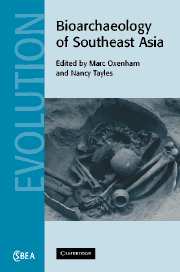Book contents
- Frontmatter
- Contents
- List of contributors
- Foreword: Emerging frontiers in the bioarchaeology of Southeast Asia
- Preface
- 1 Introduction: Southeast Asian bioarchaeology past and present
- Part I Morphological diversity, evolution and population relationships
- Part II Health, disease and quality of life
- 8 Subsistence change and dental health in the people of Non Nok Tha, northeast Thailand
- 9 Human biology from the bronze age to the iron age in the Mun River valley of northeast Thailand
- 10 Palaeodietary change among pre-state metal age societies in northeast Thailand: a study using bone stable isotopes
- 11 The oral health consequences of the adoption and intensification of agriculture in Southeast Asia
- 12 Cranial lesions on the late Pleistocene Indonesian Homo erectus Ngandong 7
- 13 ‘The predators within’: investigating the relationship between malaria and health in the prehistoric Pacific Islands
- Part III Conclusions
- Index
- References
10 - Palaeodietary change among pre-state metal age societies in northeast Thailand: a study using bone stable isotopes
Published online by Cambridge University Press: 18 November 2009
- Frontmatter
- Contents
- List of contributors
- Foreword: Emerging frontiers in the bioarchaeology of Southeast Asia
- Preface
- 1 Introduction: Southeast Asian bioarchaeology past and present
- Part I Morphological diversity, evolution and population relationships
- Part II Health, disease and quality of life
- 8 Subsistence change and dental health in the people of Non Nok Tha, northeast Thailand
- 9 Human biology from the bronze age to the iron age in the Mun River valley of northeast Thailand
- 10 Palaeodietary change among pre-state metal age societies in northeast Thailand: a study using bone stable isotopes
- 11 The oral health consequences of the adoption and intensification of agriculture in Southeast Asia
- 12 Cranial lesions on the late Pleistocene Indonesian Homo erectus Ngandong 7
- 13 ‘The predators within’: investigating the relationship between malaria and health in the prehistoric Pacific Islands
- Part III Conclusions
- Index
- References
Summary
Introduction
The use of stable isotopic analysis for reconstructing the diet of past populations has become common practice in the Americas, Europe, Africa, Japan and in the Pacific (e.g. Roksandic et al. 1988, Ambrose et al. 1997, Ambrose 2000, Sealy and Pfeiffer 2000, Larsen et al. 2001, White et al. 2001, Bocherens and Drucker 2003). Previous isotopic work to assess palaeodietary change among prehistoric human populations in Southeast Asia has been limited to Peninsular Malaysia and Sarawak (Krigbaum 2001). The project described here provides the first stable isotopic data from mainland Southeast Asia, offering a greater understanding of the interaction between environment and culture in changing food consumption patterns in prehistoric Southeast Asia.
King performed a study of human skeletal material (n = 33) from the archaeological site of Ban Chiang in northeast Thailand. The objectives of the study were to determine whether (a) carbon (from collagen and apatite) and nitrogen (from collagen) isotopic data could be collected from archaeological human remains from mainland Southeast Asia; (b) temporal changes in diet could be detected; and (c) sex differences in isotopic values could be detected. The Ban Chiang archeological site is an ideal place to start an in-depth case study examining synchronic and diachronic dietary patterns in an important and ecologically distinctive region of mainland Southeast Asia. The human skeletal remains from this important mortuary site were chosen for ease of accessibility and because the mortuary sequence spans 2300 years (1,800 to 100 BP) that encompassed both the pre-metal and pre-state metal age periods (bronze and iron) of prehistoric Thailand (Table 10.1) (Pietrusewsky and Douglas 2002a).
- Type
- Chapter
- Information
- Bioarchaeology of Southeast Asia , pp. 241 - 262Publisher: Cambridge University PressPrint publication year: 2006
References
- 6
- Cited by



